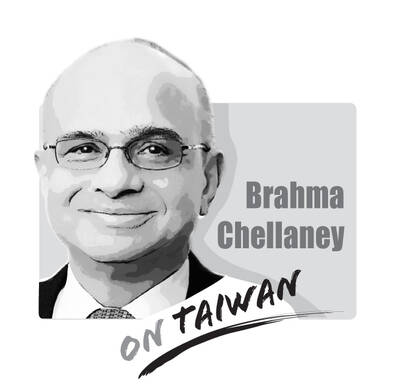Though welcome, the US$6.4 billion US arms sale to Taiwan announced by Washington on Friday will not bring much in terms of Taiwan’s ability to defend itself. All the items in the package, with the exception of the 60 UH-60M Black Hawk helicopters, had been approved — and then delayed — by former US president George W. Bush’s administration. In other words, since large parts of the package were first announced in 2001, Taiwan’s military has been treading water, while China has sprinted ahead with the modernization of its military.
None of the items in the package will make a substantial difference. While the PAC-3 missile defense system can bolster the defense of certain key targets, it is not sufficient to deter an attack, especially as the sale is likely to result in a decision by the People’s Liberation Army (PLA) to add short and medium-range missiles to the 1,500 it already aims at Taiwan and step up its missile program.
What is needed most, and what the US appears unlikely to provide anytime soon, is newer fighter aircraft like F-16C/Ds. With every day that passes, Taiwan’s aging fleet lags further behind the PLA air force, which is developing 4.5 and fifth-generation aircraft that are far superior. As Taiwan’s air force retires some of its Mirage and F-5s, among others, the balance of air power will only widen, both in quantitative and qualitative terms.
Nothing underscores the lack of punch in the arms release more than the fact that the 10 RTM-84L Harpoon missiles and two ATM-84L Harpoon missiles included in the package, which cost US$37 million, are for training purposes only. They are simply unarmed variants of the real thing — RGM/AGM-84As.
At best, the arms sale was an expression of US commitment to the defense of Taiwan, as per the Taiwan Relations Act (TRA). In terms of symbolic value, the move is welcome. But it comes short of providing the types of weapon that are necessary to ensure Taiwan’s ability to defend itself in line with the amplitude of the Chinese threat — as stipulated in the TRA. It also comes in the wake of another announcement by Washington that it had downgraded China as an intelligence priority.
Still, despite the severe limitations in the arms sale, Beijing went through the motions and threatened to scuttle planned visits by US officials such as Secretary of Defense Robert Gates, to suspend Sino-US military links and to impose sanctions targeting US companies involved in the sale.
In the past, when China rattled its saber over US arms sales to Taiwan, it did so over weaponry that made a significant difference in the balance of power in the Taiwan Strait. Now, however, after years of dithering in Washington, Beijing has become confident enough that it can throw a fit — and make Washington pause — over practically inconsequential weapons sales. This substantiates fears by some Washington sources that this could be the first and last arms sale to Taiwan under US President Barack Obama’s administration.
Pressure by US firms targeted by retaliatory sanctions, especially Boeing, which derives about 4 percent of its total revenues from China and estimates that China will need 3,770 new aircraft — worth as much as US$400 billion — by 2028, are sure to weigh against future arms sales.
If China can brew such a storm over what is an arms sale that was meant to please all sides and minimize the damage to Sino-US relations, then the chances of Taiwan getting the weapons it really needs look alarmingly slim.
Recently, China launched another diplomatic offensive against Taiwan, improperly linking its “one China principle” with UN General Assembly Resolution 2758 to constrain Taiwan’s diplomatic space. After Taiwan’s presidential election on Jan. 13, China persuaded Nauru to sever diplomatic ties with Taiwan. Nauru cited Resolution 2758 in its declaration of the diplomatic break. Subsequently, during the WHO Executive Board meeting that month, Beijing rallied countries including Venezuela, Zimbabwe, Belarus, Egypt, Nicaragua, Sri Lanka, Laos, Russia, Syria and Pakistan to reiterate the “one China principle” in their statements, and assert that “Resolution 2758 has settled the status of Taiwan” to hinder Taiwan’s

Can US dialogue and cooperation with the communist dictatorship in Beijing help avert a Taiwan Strait crisis? Or is US President Joe Biden playing into Chinese President Xi Jinping’s (習近平) hands? With America preoccupied with the wars in Europe and the Middle East, Biden is seeking better relations with Xi’s regime. The goal is to responsibly manage US-China competition and prevent unintended conflict, thereby hoping to create greater space for the two countries to work together in areas where their interests align. The existing wars have already stretched US military resources thin, and the last thing Biden wants is yet another war.
As Maldivian President Mohamed Muizzu’s party won by a landslide in Sunday’s parliamentary election, it is a good time to take another look at recent developments in the Maldivian foreign policy. While Muizzu has been promoting his “Maldives First” policy, the agenda seems to have lost sight of a number of factors. Contemporary Maldivian policy serves as a stark illustration of how a blend of missteps in public posturing, populist agendas and inattentive leadership can lead to diplomatic setbacks and damage a country’s long-term foreign policy priorities. Over the past few months, Maldivian foreign policy has entangled itself in playing
A group of Chinese Nationalist Party (KMT) lawmakers led by the party’s legislative caucus whip Fu Kun-chi (?) are to visit Beijing for four days this week, but some have questioned the timing and purpose of the visit, which demonstrates the KMT caucus’ increasing arrogance. Fu on Wednesday last week confirmed that following an invitation by Beijing, he would lead a group of lawmakers to China from Thursday to Sunday to discuss tourism and agricultural exports, but he refused to say whether they would meet with Chinese officials. That the visit is taking place during the legislative session and in the aftermath